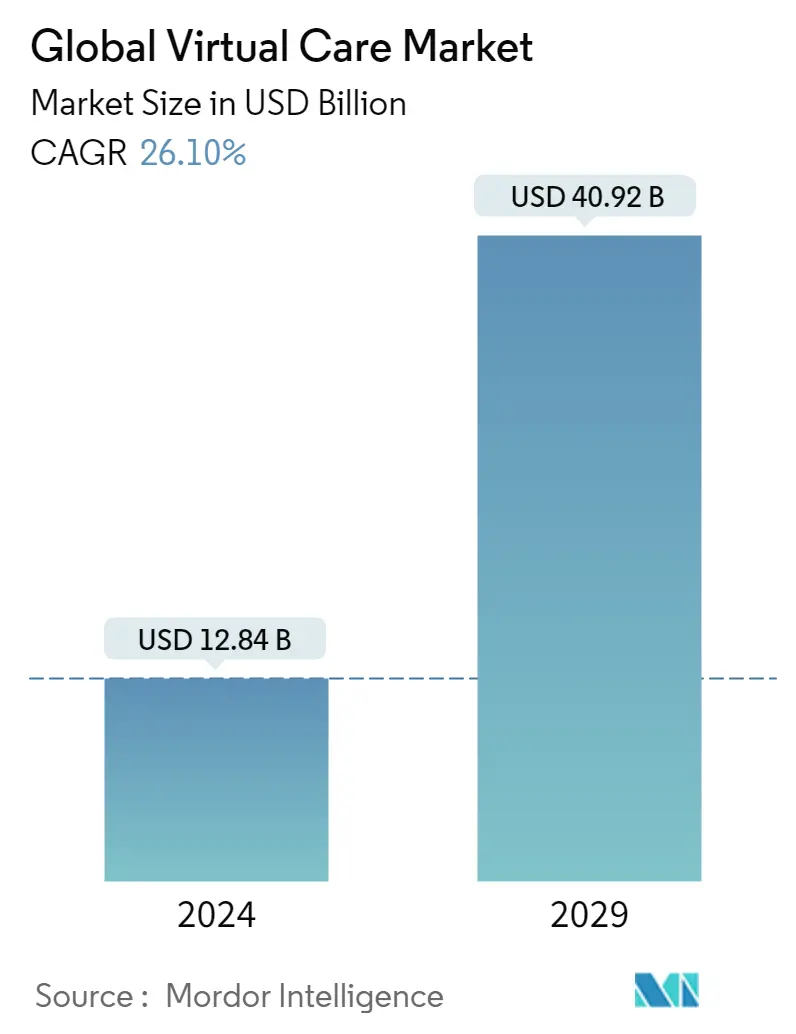Market Size of Global Virtual Care Industry

| Study Period | 2019 - 2029 |
| Market Size (2024) | USD 12.84 Billion |
| Market Size (2029) | USD 40.92 Billion |
| CAGR (2024 - 2029) | 26.10 % |
| Fastest Growing Market | Asia-Pacific |
| Largest Market | North America |
Major Players
*Disclaimer: Major Players sorted in no particular order |
Virtual Care Market Analysis
The Global Virtual Care Market size is estimated at USD 12.84 billion in 2024, and is expected to reach USD 40.92 billion by 2029, growing at a CAGR of 26.10% during the forecast period (2024-2029).
The COVID-19 pandemic had a positive impact on the virtual care market. The pandemic has increased the adoption of virtual care assistance among people of all age groups. Initially, the concept of virtual care was restricted to certain age groups, such as youngsters. However, with the advent of COVID-19, the term "virtual care" gained significant prominence among all patients, irrespective of their age. For instance, as per the survey conducted by the Canadian Medical Association (CMA) in June 2020, during the COVID-19 crisis, 47% of Canadians used "virtual care" such as phone calls, emails, messages, or videos during the outbreak. Ninety-one percent indicated they were incredibly satisfied with their visit. The same source further stated that 34% of individuals who required advice during the pandemic contacted their doctor by phone. However, only 10% saw a doctor in person, 6% went to a walk-in clinic, and 5% went to an emergency department. Furthermore, according to Canada Health Infoway, about 4% of primary care visits in Canada were done remotely (by phone, video, text, or app) before the pandemic was declared. Therefore, such instances indicate the demand for virtual care solutions bolstered during the pandemic phase.
Furthermore, the mutual advantages offered by virtual care for both doctors and patients are one of the major factors driving the market's growth. Through virtual care, patients can undergo consultation from home. It also helps to bridge the gap between patient and doctor, as doctors can reach out to more patients virtually rather than through physical consultation. In addition, virtual care is much more inexpensive than physical consultation as no traveling costs or waiting time are involved. The rising adoption of virtual care has encouraged many key and small players to launch services related to virtual care. For instance, in November 2021, LifeMD launched its virtual care platform to enable affordable and accessible healthcare 24/7 to patients globally. Likewise, in April 2022, with a USD 300 million Series D investment led by growth equity company General Atlantic, Biofourmis, a pioneer in virtual care and digital medicine, achieved unicorn status. Biofourmis intends to expand its virtual care offerings with this financing. This involves providing individualized and predictive in-home care to an increasing number of acutely ill patients and expanding Biofourmis Care, its virtual specialist care service, to patients with complicated chronic diseases. Parallelly, Biofourmis intends to fund clinical trials to accelerate the development of digital medicines that collaborate with high-value medications to boost efficacy and build strategic relationships with firms in digital health and virtual-first care ecosystems. Such innovations are anticipated to drive the market over the forecast period.
Therefore, owing to the above-mentioned factors, the studied market is anticipated to witness considerable growth over the analysis period. However, hospital integration issues and the chances of data breaches leading to compromised privacy are likely to impede the market's growth.
Virtual Care Industry Segmentation
Per the report's scope, virtual care generally enables patients to undergo online consultation with doctors from anywhere. Virtual care generally includes consultation through live audio, video, and instant messaging as a mode of communication with the patients remotely. The virtual care market is segmented by mode of delivery (video, audio, and messaging), component (solutions and services), end user (home healthcare, hospitals, and others), and geography (North America, Europe, Asia-Pacific, Middle East and Africa, and South America). The market report also covers the estimated market sizes and trends for 17 countries across major global regions. The report offers the value (in USD million) for the above segments.
| By Mode of Delivery | |
| Video | |
| Audio | |
| Messaging |
| By Component | |
| Solutions | |
| Services |
| By End Users | |
| Home Healthcare | |
| Hospitals | |
| Others |
| Geography | ||||||||
| ||||||||
| ||||||||
| ||||||||
| ||||||||
|
Global Virtual Care Market Size Summary
The virtual care market is poised for substantial growth, driven by the increasing adoption of digital health solutions across various demographics. The COVID-19 pandemic significantly accelerated the acceptance and utilization of virtual care, expanding its reach beyond younger populations to include all age groups. This shift was facilitated by the need for remote consultations, which proved to be more convenient and cost-effective compared to traditional in-person visits. The pandemic highlighted the benefits of virtual care, such as reduced travel costs, minimized waiting times, and the ability to maintain social distancing, thereby enhancing patient satisfaction and encouraging widespread adoption. The market is further bolstered by innovations and investments from both established and emerging players, who are expanding their virtual care offerings to meet the growing demand for accessible and affordable healthcare solutions.
North America is expected to lead the virtual care market, supported by a robust infrastructure, a high concentration of healthcare startups, and proactive government initiatives aimed at enhancing virtual healthcare access. The region's market growth is fueled by strategic service launches and the presence of key players who are continuously innovating to improve virtual care delivery. Despite the promising growth prospects, the market faces challenges such as integration issues with existing healthcare systems and concerns over data privacy. However, the increasing prevalence of home healthcare solutions, such as virtual wards, is anticipated to drive further expansion, particularly in regions where traditional healthcare facilities are strained. The competitive landscape remains fragmented, with numerous global and regional companies vying for market share, each contributing to the dynamic evolution of the virtual care industry.
Global Virtual Care Market Size - Table of Contents
-
1. MARKET DYNAMICS
-
1.1 Market Overview
-
1.2 Market Drivers
-
1.2.1 Increasing Number of Patients Adopting Virtual Care and Government Initiatives Towards Virtual Care Access
-
1.2.2 Advantages Of Virtual Care and New Service Launches by Market Players
-
-
1.3 Market Restraints
-
1.3.1 Lack of Physician Support and Hospital Integration Issues Due to Privacy Concerns
-
-
1.4 Porter's Five Forces Analysis
-
1.4.1 Threat of New Entrants
-
1.4.2 Bargaining Power of Buyers and Consumers
-
1.4.3 Bargaining Power of Suppliers
-
1.4.4 Threat of Substitute Products
-
1.4.5 Intensity of Competitive Rivalry
-
-
-
2. MARKET SEGMENTATION (Market Size by Value - in USD Million)
-
2.1 By Mode of Delivery
-
2.1.1 Video
-
2.1.2 Audio
-
2.1.3 Messaging
-
-
2.2 By Component
-
2.2.1 Solutions
-
2.2.2 Services
-
-
2.3 By End Users
-
2.3.1 Home Healthcare
-
2.3.2 Hospitals
-
2.3.3 Others
-
-
2.4 Geography
-
2.4.1 North America
-
2.4.1.1 United States
-
2.4.1.2 Canada
-
2.4.1.3 Mexico
-
-
2.4.2 Europe
-
2.4.2.1 Germany
-
2.4.2.2 United Kingdom
-
2.4.2.3 France
-
2.4.2.4 Italy
-
2.4.2.5 Spain
-
2.4.2.6 Rest of Europe
-
-
2.4.3 Asia-Pacific
-
2.4.3.1 China
-
2.4.3.2 Japan
-
2.4.3.3 India
-
2.4.3.4 Australia
-
2.4.3.5 South Korea
-
2.4.3.6 Rest of Asia-Pacific
-
-
2.4.4 Middle East and Africa
-
2.4.4.1 GCC
-
2.4.4.2 South Africa
-
2.4.4.3 Rest of Middle East and Africa
-
-
2.4.5 South America
-
2.4.5.1 Brazil
-
2.4.5.2 Argentina
-
2.4.5.3 Rest of South America
-
-
-
Global Virtual Care Market Size FAQs
How big is the Global Virtual Care Market?
The Global Virtual Care Market size is expected to reach USD 12.84 billion in 2024 and grow at a CAGR of 26.10% to reach USD 40.92 billion by 2029.
What is the current Global Virtual Care Market size?
In 2024, the Global Virtual Care Market size is expected to reach USD 12.84 billion.

